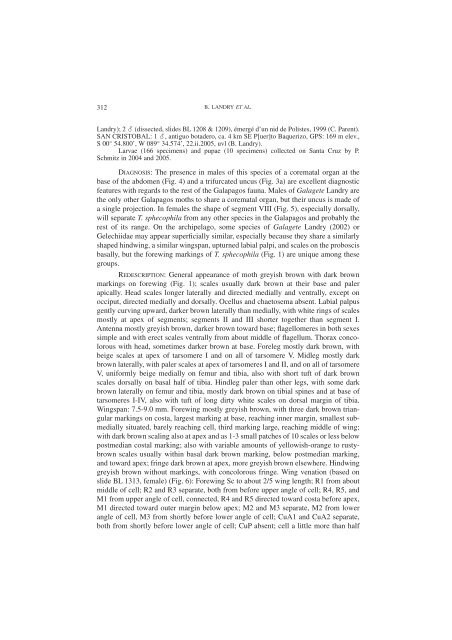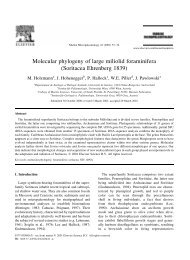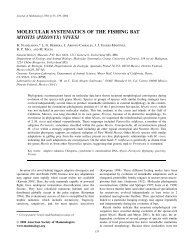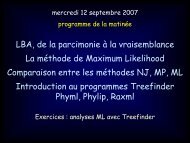Landry et al. 2006.pdf - Webspace
Landry et al. 2006.pdf - Webspace
Landry et al. 2006.pdf - Webspace
You also want an ePaper? Increase the reach of your titles
YUMPU automatically turns print PDFs into web optimized ePapers that Google loves.
312B. LANDRY ET AL.<strong>Landry</strong>); 2 (dissected, slides BL 1208 & 1209), émergé d’un nid de Polistes, 1999 (C. Parent).SAN CRISTOBAL: 1 , antiguo botadero, ca. 4 km SE P[uer]to Baquerizo, GPS: 169 m elev.,S 00° 54.800’, W 089° 34.574’, 22.ii.2005, uvl (B. <strong>Landry</strong>).Larvae (166 specimens) and pupae (10 specimens) collected on Santa Cruz by P.Schmitz in 2004 and 2005.DIAGNOSIS: The presence in m<strong>al</strong>es of this species of a coremat<strong>al</strong> organ at thebase of the abdomen (Fig. 4) and a trifurcated uncus (Fig. 3a) are excellent diagnosticfeatures with regards to the rest of the G<strong>al</strong>apagos fauna. M<strong>al</strong>es of G<strong>al</strong>ag<strong>et</strong>e <strong>Landry</strong> ar<strong>et</strong>he only other G<strong>al</strong>apagos moths to share a coremat<strong>al</strong> organ, but their uncus is made ofa single projection. In fem<strong>al</strong>es the shape of segment VIII (Fig. 5), especi<strong>al</strong>ly dors<strong>al</strong>ly,will separate T. sphecophila from any other species in the G<strong>al</strong>apagos and probably therest of its range. On the archipelago, some species of G<strong>al</strong>ag<strong>et</strong>e <strong>Landry</strong> (2002) orGelechiidae may appear superfici<strong>al</strong>ly similar, especi<strong>al</strong>ly because they share a similarlyshaped hindwing, a similar wingspan, upturned labi<strong>al</strong> p<strong>al</strong>pi, and sc<strong>al</strong>es on the proboscisbas<strong>al</strong>ly, but the forewing markings of T. sphecophila (Fig. 1) are unique among thesegroups.REDESCRIPTION: Gener<strong>al</strong> appearance of moth greyish brown with dark brownmarkings on forewing (Fig. 1); sc<strong>al</strong>es usu<strong>al</strong>ly dark brown at their base and p<strong>al</strong>erapic<strong>al</strong>ly. Head sc<strong>al</strong>es longer later<strong>al</strong>ly and directed medi<strong>al</strong>ly and ventr<strong>al</strong>ly, except onocciput, directed medi<strong>al</strong>ly and dors<strong>al</strong>ly. Ocellus and cha<strong>et</strong>osema absent. Labi<strong>al</strong> p<strong>al</strong>pusgently curving upward, darker brown later<strong>al</strong>ly than medi<strong>al</strong>ly, with white rings of sc<strong>al</strong>esmostly at apex of segments; segments II and III shorter tog<strong>et</strong>her than segment I.Antenna mostly greyish brown, darker brown toward base; flagellomeres in both sexessimple and with erect sc<strong>al</strong>es ventr<strong>al</strong>ly from about middle of flagellum. Thorax concolorouswith head, som<strong>et</strong>imes darker brown at base. Foreleg mostly dark brown, withbeige sc<strong>al</strong>es at apex of tarsomere I and on <strong>al</strong>l of tarsomere V. Midleg mostly darkbrown later<strong>al</strong>ly, with p<strong>al</strong>er sc<strong>al</strong>es at apex of tarsomeres I and II, and on <strong>al</strong>l of tarsomereV, uniformly beige medi<strong>al</strong>ly on femur and tibia, <strong>al</strong>so with short tuft of dark brownsc<strong>al</strong>es dors<strong>al</strong>ly on bas<strong>al</strong> h<strong>al</strong>f of tibia. Hindleg p<strong>al</strong>er than other legs, with some darkbrown later<strong>al</strong>ly on femur and tibia, mostly dark brown on tibi<strong>al</strong> spines and at base oftarsomeres I-IV, <strong>al</strong>so with tuft of long dirty white sc<strong>al</strong>es on dors<strong>al</strong> margin of tibia.Wingspan: 7.5-9.0 mm. Forewing mostly greyish brown, with three dark brown triangularmarkings on costa, largest marking at base, reaching inner margin, sm<strong>al</strong>lest submedi<strong>al</strong>lysituated, barely reaching cell, third marking large, reaching middle of wing;with dark brown sc<strong>al</strong>ing <strong>al</strong>so at apex and as 1-3 sm<strong>al</strong>l patches of 10 sc<strong>al</strong>es or less belowpostmedian cost<strong>al</strong> marking; <strong>al</strong>so with variable amounts of yellowish-orange to rustybrownsc<strong>al</strong>es usu<strong>al</strong>ly within bas<strong>al</strong> dark brown marking, below postmedian marking,and toward apex; fringe dark brown at apex, more greyish brown elsewhere. Hindwinggreyish brown without markings, with concolorous fringe. Wing venation (based onslide BL 1313, fem<strong>al</strong>e) (Fig. 6): Forewing Sc to about 2/5 wing length; R1 from aboutmiddle of cell; R2 and R3 separate, both from before upper angle of cell; R4, R5, andM1 from upper angle of cell, connected, R4 and R5 directed toward costa before apex,M1 directed toward outer margin below apex; M2 and M3 separate, M2 from lowerangle of cell, M3 from shortly before lower angle of cell; CuA1 and CuA2 separate,both from shortly before lower angle of cell; CuP absent; cell a little more than h<strong>al</strong>f






